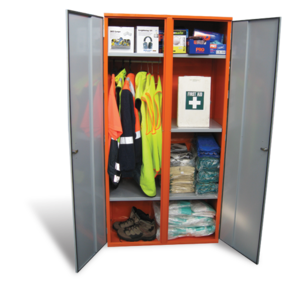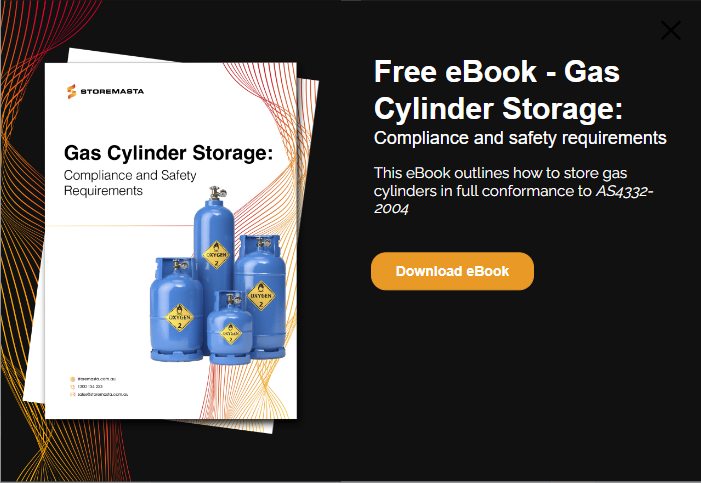If gas cylinders are present at a worksite, all personnel involved in cylinder handling and storage must be provided with appropriate personal protective equipment. This post discusses the personal protective equipment requirements under the Australian Standard AS 4332-2004 - The storage and handling of gases in cylinders. We’ll highlight the importance of choosing suitable PPE for handling gas cylinders, as well as finding a safe, well-identified location to keep your equipment, so it’s always ready for use.
Types of personal protective equipment
Selecting the right PPE for each specific job task that involves gas cylinders is essential. The PPE you select will always be determined by conducting a risk assessment that includes consulting the Safety Data Sheets (SDSs) for each of the gases you are using. The SDS will have a section that will outline the PPE that is required.
Check the example below from a chlorine gas document:
Wear overalls, chemical goggles, full face shield and elbow-length impervious gloves to protect exposed skin and eyes. You should always use personal protective equipment for gas cylinder handling in an environment with adequate ventilation.

The type of gas at your site, as well as the handling tasks that you perform, will assist in determining the PPE that you wear.
If determined by a risk assessment an inhalation risk exists, staff should wear an air-supplied mask that meets the requirements of AS/NZS 1715 and AS/NZS 1716.
We’ve listed below the required PPE outlined in the Standard and included some key considerations when making your decision on what to use.
Eye protection
Workers should always wear eye protection when handling compressed gases. Ordinary safety glasses are not suitable because even Class 2.2 Non-toxic gases can cause eye damage if released suddenly from a cylinder. An uncontrolled release of compressed gas can dislodge metal shavings and create other dangerous projectiles. Check the impact resistance of the eyewear you are considering before making your decision.
When employees are working with toxic or corrosive gases — such as chlorine or ammonia — they’ll need chemical goggles that dangerous gases cannot penetrate.
You must always check the recommendations of the Safety Data Sheet to ensure that the eye guards, goggles or face shield being used comply with AS/NZS 1337. You should also make sure the eyewear fits each of your workers properly, as loose-fitting goggles can cause accidents through slippage or cause workers to take them off prematurely.
Protective gloves
Protective gloves should be worn when handling cylinders. Again, your decision about what type of gloves to use (PVC gloves, insulating gloves etc) will be based on the type of gases at the worksite — and how they are being used. Protective gloves must comply with AS/NZS 2161.
Working gloves should protect hands from abrasions, cuts, tears and punctures while transferring or moving cylinders. When breaking transfers or transfilling gases that create a thermal hazard, cold insulating gloves will be required.
Gloves for changing propane tanks
Insulating gloves must be worn if staff are working with or changing propane cylinders. These propane cylinder handling gloves provide protection against frost burn, which can occur if skin is exposed to extremely cold propane gas.
Gloves for handling LPG leaks
What PPE must you wear when handling LPG? AS NZS 1596:2008 – The storage and handling of LP gas explains that protective gloves must be worn when handling any type of equipment that could involve LPG. The gloves should be worn during tasks such as decanting or motor vehicle refuelling, to minimise exposure. While LPG is not a toxic gas, if LPG cylinders are leaking, the gloves will assist in protecting the skin from cold burns.
Safety footwear
Cylinders are heavy and have caused many fractures and other serious injuries to feet and toes. Workers should always be wearing protective footwear that complies with AS/NZS 2210.2. Refer to AS/NZS 2210.1 for advice on selecting and maintaining footwear.
Breathing apparatus
You need to consider breathing apparatus that conforms with AS/NZS 1716 if you keep or handle toxic gases at your worksite. Also, if there is any chance of an oxygen deficient atmosphere occurring. Depending on your worksite you might need self-contained chemical oxygen breathing apparatus or a continuous airline system.
Protective clothing
The Standard recommends wearing protective clothing, such as overalls, when moving or handling gas cylinders.
Hearing protection
If hearing protection is required, the ear guards must comply with AS/NZS 1270.
Care and maintenance of personal protective equipment
Safety is compromised and accidents occur when PPE is not returned to its location point at the end of a shift. There should always be sufficient PPE on-hand for incoming workers, so lost or damaged PPE must be reported without delay.
PPE must be kept clean and maintained. Contaminated clothing and other protective equipment should be washed and cleaned before storage or re-use. Self-contained breathing apparatus must be maintained in accordance with AS/NZS 1715.
 Your personal protective equipment should be kept in a clearly marked location, that helps protect the PPE from damage.
Your personal protective equipment should be kept in a clearly marked location, that helps protect the PPE from damage.
Training staff to use PPE
Staff should be instructed to wear PPE like overalls, protective gloves, safety footwear and eye protection when moving or handling cylinders. Hearing protection should be carried by staff at all times in case it’s required on the worksite.
Staff would be trained according to their job role and the training must include the chemical properties of the gases and the hazards associated with the cylinders.
Staff training should include:
- The type of PPE to use
- How it will protect them from gas cylinder hazards
- Their personal responsibility under the law
- Where to find the PPE
- How to use it properly
- How to clean it and keep it safely maintained
- What to do if there’s no available PPE when they arrive at the job site
- What to do if they damage or lose their PPE
When self-contained breathing apparatus (SCBA) is provided for responding to a gas leak or air deficient environment, intensive emergency training that include simulated drills would be required.
Protecting Exposed Skin and Airways with PPE
If you work with compressed gases in cylinders, such as propane or LPG, you’ll need detailed information about how to manage the risks. Our free, eBook Gas Cylinder Storage: Compliance and safety requirements, is perfect for WHS Managers and other staff who are responsible for risk management and Dangerous Goods storage. Download and read our handy guide, so you can make your cylinder handling procedures safer and compliant.
Joining the team as a Dangerous Goods Storage Consultant, Melissa Hampton became Storemasta's Marketing Manager in late 2021. With extensive knowledge and experience in chemical compliance, Melissa is responsible for leading the Marketing team and helping shape their marketing strategy. In her spare time, you can find Melissa hiking, swimming and enjoying the great outdoors in beautiful north-west Tasmania.
